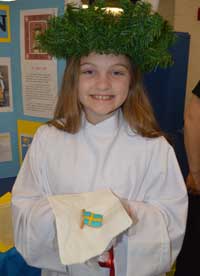Musa Hammad admitted he didn’t make the baba ghanoush he was passing out samples of smeared on pita bread, but the sixth-grader said he eats the eggplant-based dip that is so popular in his family’s native Palestine “most of the time.”
Bella Romero stood with her dad at the booth she decorated, sharing pieces of lemon bizcocho, or Spanish lemon cake, and tales of bullfighting and soccer prowess.”I went there for the summer when I was 10,” said the fifth-grader. “It was very pretty. There are a lot more apartments than here.”
Forty-two languages are spoken by students and their families at Northern Trails ⅚ Elementary. They include Albanian, Amharic, Arabic, Armenian, Bahasa (Indonesian), Bosnian, Carma (Cambodian), Chaldean, Chinese Mandarin, Croatian, Dutch, Eritrean, French, Gaelic, Gujurati, Hebrew, Hindi, Italian, Japanese, Korean, Malayalam, Marathi, Montenegrin, Nepali, Newari (Nepal), Oromo, Punjabi, Polish, Portuguese, Romanian, Russian, Servian, Somalian, Spanish, Sudanese, Tagalog, Tamil, Telugu, Tigrynia, Urdu and Vietnamese.
For a few hours on a recent Friday afternoon, the gymnasium and cafeteria at Northern Trails ⅚ Elementary was transformed into an around-the-world experience for hundreds of students and their family members.
The multi-generational International Fair, held every two years at the school since it opened in 1998, is aimed at showcasing the school’s ethnic diversity and providing a voluntary opportunity for students who want to learn about their heritage or one that simply intrigued them.

Seventy-five countries on five continents were represented through displays that included cultural information, traditional clothing, music and games. And oh, the food.
There were chocolate crepes from France; Mexican buñuelo, a doughnut hole-like fried cookie; smoked gouda cheese from the Netherlands and dabul bread from Ethiopia.
Besides munching as incentive, students perused booths looking to answer several questions that required them to further investigate cultures they did not know a lot about: for example, two countries where people traditionally keep their heads covered, a country with free college, types of houses and major construction materials and one difference and one similarity between a country and the U.S.
CONNECT









